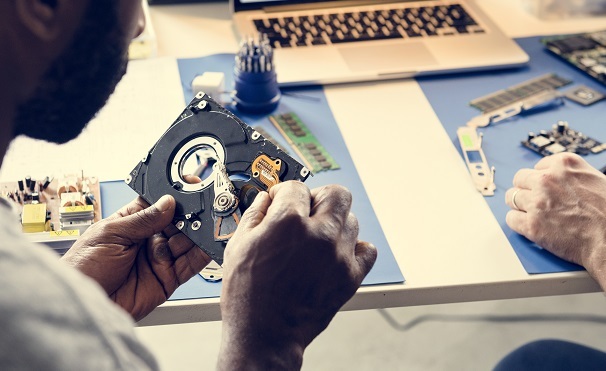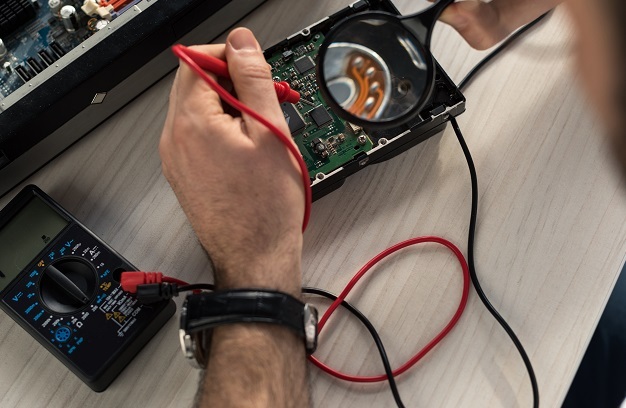
 Data Structure
Data Structure Networking
Networking RDBMS
RDBMS Operating System
Operating System Java
Java MS Excel
MS Excel iOS
iOS HTML
HTML CSS
CSS Android
Android Python
Python C Programming
C Programming C++
C++ C#
C# MongoDB
MongoDB MySQL
MySQL Javascript
Javascript PHP
PHP
- Selected Reading
- UPSC IAS Exams Notes
- Developer's Best Practices
- Questions and Answers
- Effective Resume Writing
- HR Interview Questions
- Computer Glossary
- Who is Who
What is the full form of EIDE?
Definition of EIDE
Enhanced Integrated Drive Electronics (EIDE) is a standard interface utilised for connecting hard disk drives, CD-ROM drives, and other storage gadgets to a computer's motherboard.

It is a progressed version of the older IDE standard and gives faster information transfer rates and bigger storage capacity support. EIDE is additionally known as ATA-2 or ATA/33.
History and Evolution of EIDE
Here's a brief history and evolution of EIDE
-
IDE (Integrated Drive Electronics):
IDE was introduced in the 1980s as a standard interface for interfacing HDDs to PCs. It utilised a 40-pin connector and bolstered information exchange rates of up to 2 megabytes per second (MB/s). IDE included a parallel interface, where information was transmitted in parallel over different wires.
-
ATA (AT Attachment)
ATA was introduced in the early 1990s as an upgrade of IDE. It moved forward the information exchange rates to up to 8.3 MB/s and introduced modern features such as support for bigger hard drives and improved error correction. ATA too introduced the use of an extra 4 pins on the connector for providing control to the drive, thus the name "AT Attachment."
-
EIDE (Enhanced IDE)
EIDE was introduced in the mid-1990s as an expansion of ATA. It included additional features such as support for faster information exchange rates (up to 16.6 MB/s) and the ability to connect up to four drives on a single IDE interface utilising master/slave setups. EIDE also introduced support for modern drive types like CD-ROMs and tape drives, expanding the run of devices that could be connected using the IDE interface.
-
Ultra ATA (ATA/ATAPI-4)
Ultra ATA was introduced in the late 1990s as an assist upgrade of EIDE. It expanded the data exchange rates to up to 33 MB/s and introduced new highlights like speedier bus mastering and improved error correction. Ultra ATA also added support for ATAPI (ATA Packet Interface), allowing for the association of extra gadgets like CD/DVD drives and other optical drives.
-
ATA/ATAPI-5, ATA/ATAPI-6, ATA/ATAPI-7
These measures proceeded to advance with enhancements in information exchange rates, error rectification, and support for bigger difficult drives. ATA/ATAPI-5 supported information exchange rates of up to 66 MB/s, ATA/ATAPI-6 supported up to 100 MB/s, and ATA/ATAPI-7 supported up to 133 MB/s.
-
SATA (Serial ATA)
SATA was introduced in the early 2000s as a substitution for the parallel IDE interface. It uses a serial interface, where information is transmitted successively over a single wire, allowing for higher information exchange rates and improved signal integrity. SATA has become the prevailing standard for interfacing difficult drives and other storage gadgets to PCs, with different versions supporting information exchange rates up to 6 gigabits per second (Gbps) or higher.
-
SATA Express, M.2, and PCIe/NVMe
These are newer standards that have been presented in recent years, giving indeed higher information exchange rates and smaller frame variables for storage devices. SATA Express combines SATA and PCIe technologies to supply higher speeds, while M.2 is a small form factor that permits for high-speed capacity devices to be directly associated with the motherboard. PCIe/NVMe (Non-Volatile Memory Express) is a high-speed interface that employs PCIe paths for information exchange, providing indeed faster speeds than SATA and M.2.
Features of EIDE
It has a few highlights that make it broadly utilised in the past
Faster Information Exchange Rates EIDE introduced faster information transfer rates compared to the initial IDE standard, permitting for quicker access to information stored on HDDs. EIDE supported information transfer rates of up to 16.6 MB/s, which was a significant improvement over the initial IDE standard.
Support for Multiple Drives EIDE permitted for the association of up to four drives on a single IDE interface utilising master/slave configurations. This permitted for increased capacity and flexibility in configuring numerous HDDs or other devices in a single system.
Backward Compatibility EIDE maintained backward compatibility with the original IDE standard, which implies that IDE gadgets might still be utilised with EIDE interfacing. This permitted for smooth transition and overhaul of frameworks without having to replace existing IDE gadgets.
Support for Different Drive Types EIDE introduced support for new drive sorts such as CD-ROMs and tape drives, growing the extent of gadgets that can be associated using the IDE interface. This made EIDE a flexible choice for interfacing different sorts of storage gadgets to PCs.

Easy Installation EIDE interfacing were moderately straightforward to introduce, with only a few connections required using standard cables and connectors. This made it simple for end-users to include or supplant HDDs or other storage gadgets in their frameworks without requiring specialised information or tools.
Wide Adoption EIDE rapidly picked up widespread adoption in the PC industry due to its cost-effectiveness, backward compatibility, and support for numerous drives. It became the de-facto standard for interfacing HDDs and other storage gadgets to PCs for numerous years.
Wide Availability of Devices EIDE-compatible HDDs and other storage gadgets became widely accessible in the market, giving customers with a wide range of choices for storage arrangements. This expanded competition and innovation in the capacity industry, leading to advancements in innovation and affordability of storage devices.
Applications of EIDE
A few of the applications of EIDE incorporate
Personal Computers EIDE was broadly utilised in personal computers (PCs) as the primary interface for interfacing HDDs, CD-ROM drives, tape drives, and other storage gadgets. It is permitted for information exchange between the storage devices and the PC's motherboard, enabling clients to store and recover information on their computers.
Workstations and Servers EIDE was too utilised in workstations and servers, where higher capacity capacities and information exchange rates were required. It permitted the connection of numerous HDDs in a single framework, giving expanded capacity and performance for applications that required large amounts of information storage, such as databases and multimedia servers.
Consumer Electronics EIDE was utilised in consumer electronics gadgets such as set-top boxes, gaming supports, and computerised video recorders (DVRs) for capacity purposes. It gives a cost-effective and broadly accessible storage arrangement for these devices, permitting information storage and recovery in customer electronic products.
Mechanical and Implanted Frameworks EIDE was utilised in mechanical and inserted frameworks where capacity gadgets were required for information logging, information capacity, and information recovery purposes. EIDE's in reverse compatibility and ease of establishment made it an appropriate choice for these applications, particularly in bequest frameworks where EIDE-compatible gadgets were as of now in use.
Data Recovery and Forensics EIDE was utilised in data recovery and forensics applications, where the ability to associate and recover information from distinctive sorts of storage devices was critical. EIDE interfaces allowed data recovery experts and forensic experts to put through and recover information from HDDs, CD-ROMs, and other capacity devices for information analysis, evidence collection, and investigation purposes.
Conclusion
In conclusion, Enhanced Integrated Drive Electronics (EIDE) was a broadly utilised interface for connecting hard disk drives (HDDs) and other storage devices to individual computers, workstations, servers, consumer electronics, industrial and inserted frameworks, and information recovery/forensics applications. EIDE is given a cost-effective and broadly accessible storage arrangement, permitting for information capacity and recovery in different applications.
FAQs
Q1. Are EIDE drives compatible with current-generation computers?
Ans: Although newer storage interfaces have generally taken the place of EIDE in contemporary systems, EIDE drives may still be used in some old hardware or niche software. However, contemporary motherboards and systems could not include EIDE connections, necessitating the usage of adapters or converters for compatibility.
Q2. What are some EIDE substitutes?
Ans: SATA (Serial ATA), SATA Express, M.2, and PCIe/NVMe (Peripheral Component Interconnect Express/NVM Express) interfaces, which offer faster data transfer rates, greater storage capacities, and other sophisticated features, are some of the alternatives to EIDE for data storage and retrieval in modern systems.
Q3. Can one connect EIDE devices in a RAID configuration?
Ans: Yes, RAID (Redundant Array of Independent Discs) setups, which combine many drives for improved performance, data security, or both, are compatible with EIDE devices. When employing EIDE discs in a RAID configuration, the constraints of EIDE, such as reduced data transfer rates and storage capacities, should be taken into account.

